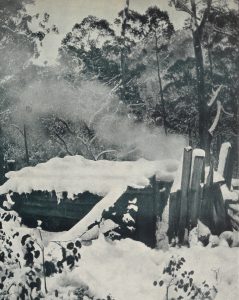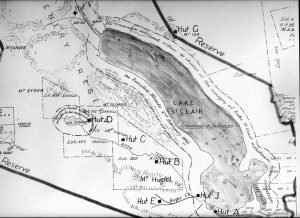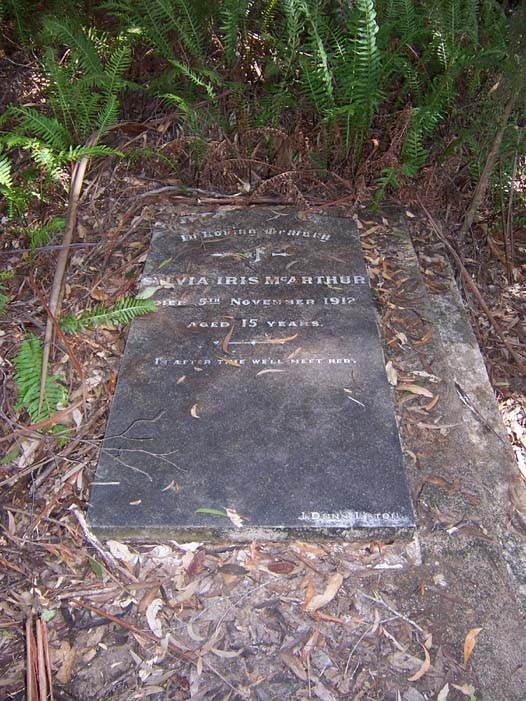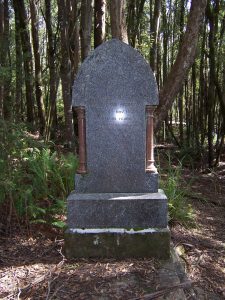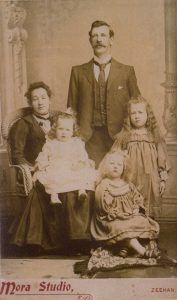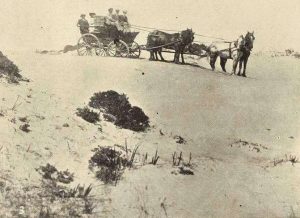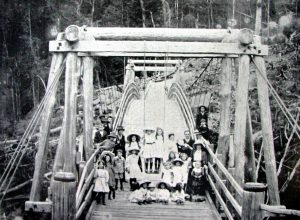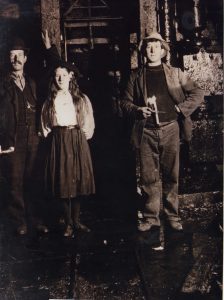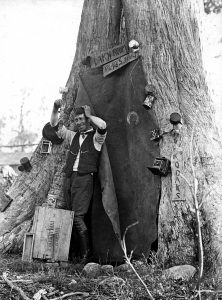
The young Herb (HJ) King was a rev-head with an artist’s eye, a man beguiled by cameras and carburettors. The frontage of his father’s motorcycle shop, John King and Sons, which he eventually took over, remains a landmark of the Kingsway, off Brisbane Street, Launceston, long after it closed. In 1921 the rival Sim King’s motorbike shop at the other end of Brisbane Street ran an advert for machines with ‘double-seated’ sidecars: ‘Take her with you!’[1] That is exactly what Herb King was already doing, the sight of his wife Lucy in the sidecar of his Indian motorbike becoming a signature of his photography in the period 1919–25.
It was perhaps King’s conservative Christadelphian faith that determined that he marry young, have children and place the role of family man before all else. He married Lucy Minna Large in Hobart in December 1918. Lucy recalled that King drove her father from Hobart to Launceston. Alighting from the car, Charles Large said ‘Oh, my boy, it’s a long way’, to which King replied, ‘Yes, Charles, what about letting Lucy and I get married at Christmas, instead of waiting?’ She was eighteen years old. He was 26.[2]
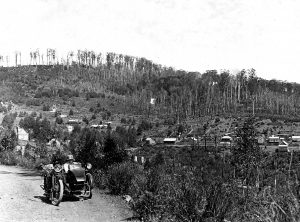
After this, before their first child was born, Lucy was a feature of King’s photography, accompanying him on most of his photographic trips. King got to Cradle Mountain slightly ahead of his nature-loving friends Fred Smithies and Ray McClinton. In December 1919 Herb, Lucy, her sister and a friend started for Cradle on motorbike and sidecar. After staying a night at Wilmot, they had Christmas dinner at Daisy Dell, Bob Quaile’s half-way house, with Lucy making a success of her first Christmas pudding. The track from Daisy Dell across the Middlesex Plains to Cradle Valley was so rough that Quaile bore most visitors along it on various horse-drawn wagonettes. Lucy recalled that on this occasion he was equipped with a two-seater:
‘He could only take one passenger and himself, and he had a horse for other people to ride. I had grown up on a farm and I was happy to ride, but my sister wouldn’t get on, and my husband got on one side and got off the other, and said ‘That’s all I’m having’. We arrived at Cradle Mountain with pounds of sausages around someone’s neck because it had rained and washed the paper off … ‘[3]
This was King’s first meeting with Gustav Weindorfer, the proprietor of Waldheim Chalet at Cradle Valley, who was then campaigning to establish a national park at Cradle Mountain. Weindorfer guided the Kings to the summit of Cradle, and it was there, with numerous peaks and Bass Strait spread out before him, that King’s plan to map the country by aerial photography was developed. ‘It was a glorious day’, King recalled, but the ‘progressive’ man of machines was impatient with foot transport:
‘ … as the afternoon was now getting on, we made a laborious descent over the great boulders and across the plateau to Waldheim. How slow the travelling was!—nearly three hours to cover a short three miles—but amidst such scenery we made light of it. We said to ‘Dorfer’ (as he afterwards became known to his friends): ‘Just fancy; if we had a ‘plane we could do the distance in under three minutes …’ Afterwards we talked as we sat inside the great fireplace of the possibilities of preparing an aerodrome in Cradle Valley, and of landing in Lake Dove with a seaplane’.[4]
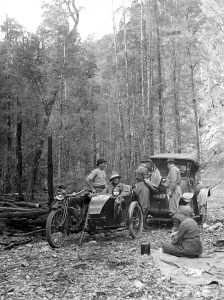
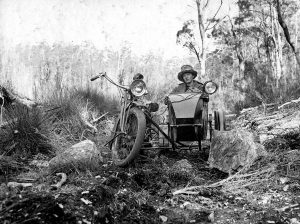
Lucy’s passive role in King’s photos belies that she could not only ride a horse, but was the first Hobart woman to own a motorcycle driver’s licence. She proved her mettle as a walker, too, when at Easter 1920 the Kings visited Pelion Plain and the upper Mersey River, with Fred and Ida Smithies, Ray and Edith McClinton, and Paddy Hartnett as a guide. This was the first time motor vehicles—that is, McClinton’s Chevrolet and King’s Indian—had entered the valley of the upper Forth River. The steep, rutted climb out of Lemonthyme Creek defeated the car until Hartnett cut wooden blocks to support the wheels. The guide also cleared a large tree off the track next day, after the party had spent a night at ‘the Farm’, that is, Mount Pelion Mines’ hut and stables near Gisborne’s Farm. The ‘Bark hut’, 3 km north of the Lone Pine wolfram mine (aka the Wolfram mine), was the terminus for the vehicles. Only Hartnett’s ingenuity and McClinton’s kit bag of cross-cut saw, axe and shovel got them that far. Now they started on foot for the mine and beyond that the Zigzag Track to the copper mine huts at Pelion Plain, a pack horse carrying much of their gear.[5] Lucy recalled walking
‘eight miles in the pouring rain and when he reached the hut at the top nobody had a dry stitch. Fortunately for the ladies there were two trappers there, and they obligingly said, ‘You come into the hut where this fire is, and get yourselves dried out, and the men will go to the other hut and make a fire for the same purpose’. The next morning when we woke up it was one of the most beautiful sights that was possible. There wasn’t a blade of grass that wasn’t covered in snow’.[6]
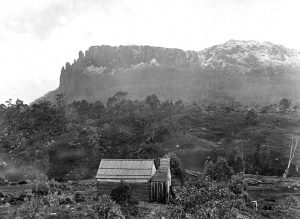
That view included Mount Oakleigh, which Herb King photographed. Members of the party visited Lake Ayr and the head of the Forth River Gorge before starting on the return journey.[7]
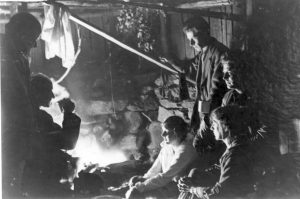
Although Paddy Hartnett never used the media, he was equally significant as Weindorfer in the development of a Cradle Mountain‒Lake St Clair National Park. Hartnett’s Du Cane Hut, also known as Cathedral Farm and Windsor Castle, was effectively his Waldheim, a tourist chalet among the mountains. King’s treks to Cradle Mountain and Pelion with their respective guides were transformational in the sense that, although he never became a hardened bushwalker like his fellow photographers Spurling, Smithies and McClinton, he did become a promoter of the Cradle Mountain-Lake St Clair National Park proposal. McClinton photos from this trip appeared in the Weekly Courier, and he, Smithies and King lantern lectured about the proposal.[8]
A slide survives of King promoting himself as a nature photographer, suggesting that he toyed with the idea of turning professional. Presumably, he decided it would not pay. The Kings were a very conservative family. His grandmother, said to be the first Christadelphian in Tasmania, was reputedly disgusted by King’s spending on photographic materials. Perhaps family influenced his choice of career. It is possible that the family motorcycle business seemed a safer bet, or that he felt obliged to follow in his father’s footsteps. Ultimately, people, family and faith meant more to King than any machine or any gadget. It was probably not just for artistic purposes—the compositional need for a foreground—that he placed Lucy in so many of his images. It signalled that she was foremost in his thinking.
[1] See, for example, Sim King advert, Examiner, 2 July 1921, p.14.
[2] Lucy King, transcript of an interview by Ross Case, 18 March 1993, OH18 (Queen Victoria Museum and Art Gallery [hereafter QVMAG]).
[3] Lucy King, transcript of an interview by Ross Case, 18 March 1993, OH18 (QVMAG).
[4] HJ King, ‘A flight to the Cradle Mountain’, Weekly Courier Christmas Annual, 3 November 1932, p.12.
[5] ‘Motors, cycles and push bikes’, Daily Telegraph, 17 April 1920, p.5.
[6] Lucy King, transcript of an interview by Ross Case, 18 March 1993, OH18 (QVMAG).
[7] ‘Motors, cycles and push bikes’, Daily Telegraph, 17 April 1920, p.5.
[8] See Weekly Courier, 15 July 1920, p.24. McClinton’s photos of the Easter 1920 trip with the Kings, Smithies and Hartnett was used here to illustrate part one of George Perrin’s account of a January 1920 trip into the same country with his wife, Florence Perrin, their friend Charlie MacFarlane and Hartnett (‘Trip to Tasmania’s highest tableland’, Weekly Courier, 8 July 1920, p.37).
